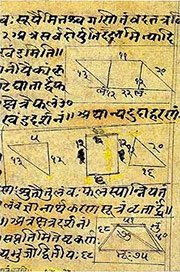Bhagahara, Bhāgahara, Bhaga-hara, Bhāgahāra: 10 definitions
Introduction:
Bhagahara means something in Hinduism, Sanskrit, the history of ancient India. If you want to know the exact meaning, history, etymology or English translation of this term then check out the descriptions on this page. Add your comment or reference to a book if you want to contribute to this summary article.
In Hinduism
Ganitashastra (Mathematics and Algebra)
Source: archive.org: Hindu MathematicsBhāgahāra (भागहार, “division”) refers to one of the twenty operations (logistics) of pāṭīgaṇita (“science of calculation which requires the use of writing material—the board”), according to Pṛthudakasvāmī’s commentary on the Brāhmasphuṭasiddhānta by Brahmagupta, a Sanskrit treatise on ancient Indian mathematics (gaṇita-śāstra) and astronomy from the 7th century.—The common Hindu names for the operation are bhāgahāra, bhājana, haraṇa, chedana, etc. All these terms literally mean “to break into parts”, i.e., “to divide”, excepting haraṇa which denotes “to take away”. This term shows the relation of division to subtraction. The dividend is termed bhājya, hārya, etc., the divisor bhājaka, bhāgahara or simply hara, and the quotient labdhi “what is obtained” or labdha.
Division (bhāgahāra) was considered to be a difficult and tedious operation by European scholars even as late as the 15th and 16th centuries; 1 but in India the operation was not considered to be difficult, as the most satisfactory method of performing it had been evolved at a very early period. In fact, no Hindu mathematician seems to have attached any great importance to this operation.
Mahāvīra in the Gaṇitasārasaṃgraha: “Putting down the dividend and below it the divisor, and then, having performed division by the method of removing common factors, give out the resulting (quotient)”

Ganitashastra (शिल्पशास्त्र, gaṇitaśāstra) refers to the ancient Indian science of mathematics, algebra, number theory, arithmetic, etc. Closely allied with astronomy, both were commonly taught and studied in universities, even since the 1st millennium BCE. Ganita-shastra also includes ritualistic math-books such as the Shulba-sutras.
India history and geography
Source: Cologne Digital Sanskrit Dictionaries: Indian Epigraphical GlossaryBhāgahara.—(EI 24), same as Bhāgin; a collector of the king's grain share. Cf. Bhāgahāra. Note: bhāgahara is defined in the “Indian epigraphical glossary” as it can be found on ancient inscriptions commonly written in Sanskrit, Prakrit or Dravidian languages.
--- OR ---
Bhāgahāra.—(HD), ‘he who recovers the [king's] share [of the procuce of land]’; one of the six officers of each village, according to Śukra, II. 120. Cf. Bhāgahara. Note: bhāgahāra is defined in the “Indian epigraphical glossary” as it can be found on ancient inscriptions commonly written in Sanskrit, Prakrit or Dravidian languages.

The history of India traces the identification of countries, villages, towns and other regions of India, as well as mythology, zoology, royal dynasties, rulers, tribes, local festivities and traditions and regional languages. Ancient India enjoyed religious freedom and encourages the path of Dharma, a concept common to Buddhism, Hinduism, and Jainism.
Languages of India and abroad
Sanskrit dictionary
Source: DDSA: The practical Sanskrit-English dictionaryBhāgahara (भागहर).—
1) a co-heir.
2) division (in math.)
Derivable forms: bhāgaharaḥ (भागहरः).
Bhāgahara is a Sanskrit compound consisting of the terms bhāga and hara (हर).
--- OR ---
Bhāgahāra (भागहार).—division (in math.).
Derivable forms: bhāgahāraḥ (भागहारः).
Bhāgahāra is a Sanskrit compound consisting of the terms bhāga and hāra (हार).
Source: Cologne Digital Sanskrit Dictionaries: Shabda-Sagara Sanskrit-English DictionaryBhāgahara (भागहर).—mfn.
(-raḥ-rā-raṃ) Taking a part, sharing. m.
(-raḥ) 1. A co-heir. 2. (In arithmetic,) Division. E. bhāga and hara who or what takes.
Source: Cologne Digital Sanskrit Dictionaries: Cappeller Sanskrit-English DictionaryBhāgahara (भागहर).—[adjective] receiving a share; [masculine] heir.
Source: Cologne Digital Sanskrit Dictionaries: Monier-Williams Sanskrit-English Dictionary1) Bhāgahara (भागहर):—[=bhāga-hara] [from bhāga] mfn. taking a part, sharing, a co-heir, [Mahābhārata]
2) Bhāgahāra (भागहार):—[=bhāga-hāra] [from bhāga] m. division, [Colebrooke]
Source: Cologne Digital Sanskrit Dictionaries: Yates Sanskrit-English DictionaryBhāgahara (भागहर):—[bhāga-hara] (raḥ-rā-raṃ) a. Taking a part. m. A co-heir; division.
[Sanskrit to German]
Sanskrit, also spelled संस्कृतम् (saṃskṛtam), is an ancient language of India commonly seen as the grandmother of the Indo-European language family (even English!). Closely allied with Prakrit and Pali, Sanskrit is more exhaustive in both grammar and terms and has the most extensive collection of literature in the world, greatly surpassing its sister-languages Greek and Latin.
Kannada-English dictionary
Source: Alar: Kannada-English corpusBhāgahāra (ಭಾಗಹಾರ):—[noun] = ಭಾಗಾಹಾರ [bhagahara].
--- OR ---
Bhāgāhāra (ಭಾಗಾಹಾರ):—[noun] (math.) the process of finding how many times a number is contained in another number; division.
Kannada is a Dravidian language (as opposed to the Indo-European language family) mainly spoken in the southwestern region of India.
See also (Relevant definitions)
Ends with: Adhobhagahara, Bhinnabhagahara, Mahayajnabhagahara, Ubhayabhagahara, Ubhayatobhagahara, Urdhvabhagahara.
Full-text (+3): Bhinnabhagahara, Ubhayabhagahara, Ubhayatobhagahara, Urdhvabhagahara, Bhagakara, Mahayajnabhagahara, Harya, Bhajaka, Chedana, Harana, Bhajana, Bhajya, Bhagara, Mahayajna, Bhagadugha, Hara, Labdhi, Labdha, Pratiloma, Bhagika.
Relevant text
No search results for Bhagahara, Bhāgahara, Bhaga-hara, Bhāga-hara, Bhāgahāra, Bhāga-hāra, Bhāgāhāra; (plurals include: Bhagaharas, Bhāgaharas, haras, Bhāgahāras, hāras, Bhāgāhāras) in any book or story.